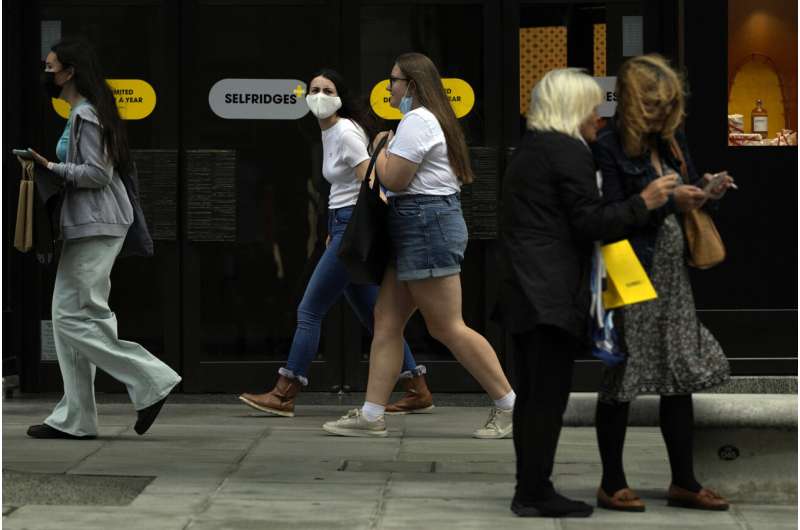
Further evidence emerged on Friday to show that the latest outbreak of the coronavirus pandemic in the U.K. has eased, with the number of people testing positive for COVID-19 falling across most parts of the country.
In its weekly survey of the levels of infection across the U.K., the Office for National Statistics said case rates appeared to be falling in England, Scotland and Wales, though not in Northern Ireland, with the declines most noticeable among younger age groups. In England, for example, the statistics agency found that one in 75 people in private households had COVID-19 in the week prior to July 31, down from one in 65 in the previous week.
The figures from the statistics agency are widely considered to be more reliable than the official government data, which are heavily reliant on testing and reporting levels within the community. The agency’s survey is based on the testing of a random sample of the population that is then extrapolated out.
Also Friday, scientists advising the British government have estimated that the coronavirus reproduction number, a gauge of transmissibility, has fallen to between 0.8 and 1.1 compared with 1.1 to 1.4 last week. That means that on average every 10 people with coronavirus will infect between 8 and 11 others. The lower end of the scale would mean the epidemic is shrinking.
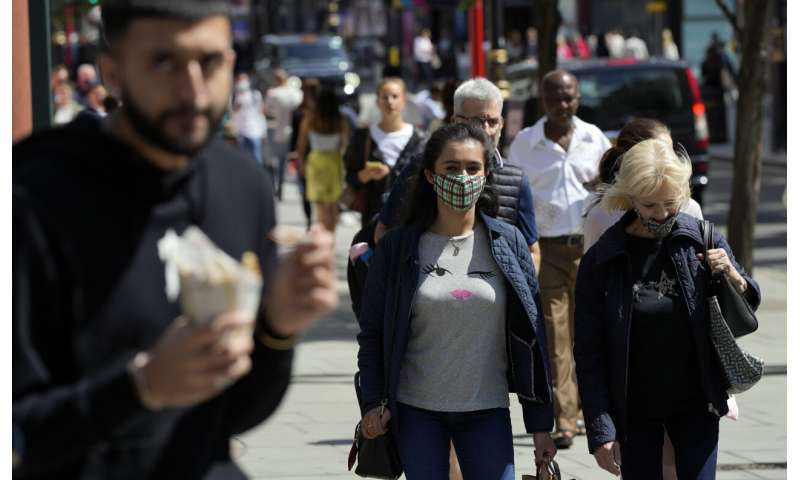 Two women walk along Oxford Street while wearing a face masks against the coronavirus in London, Friday, Aug. 6, 2021. The number of covid positive tests for August 5, the latest available figure show the United Kingdom had just over 30,000 confirmed infections. Credit: AP Photo/Alastair Grant
Two women walk along Oxford Street while wearing a face masks against the coronavirus in London, Friday, Aug. 6, 2021. The number of covid positive tests for August 5, the latest available figure show the United Kingdom had just over 30,000 confirmed infections. Credit: AP Photo/Alastair Grant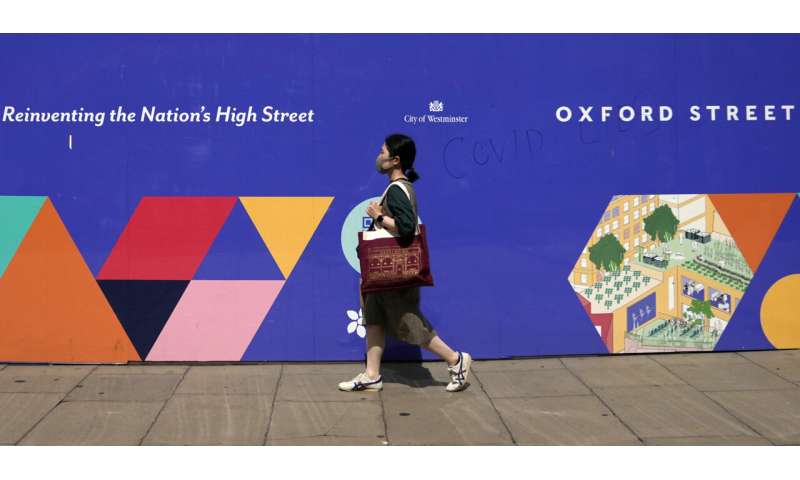 A woman walks along Oxford Street while wearing a face mask against the coronavirus in London, Friday, Aug. 6, 2021. The number of covid positive tests for August 5, the latest available figure show the United Kingdom had just over 30,000 confirmed infections. Credit: AP Photo/Alastair Grant
A woman walks along Oxford Street while wearing a face mask against the coronavirus in London, Friday, Aug. 6, 2021. The number of covid positive tests for August 5, the latest available figure show the United Kingdom had just over 30,000 confirmed infections. Credit: AP Photo/Alastair Grant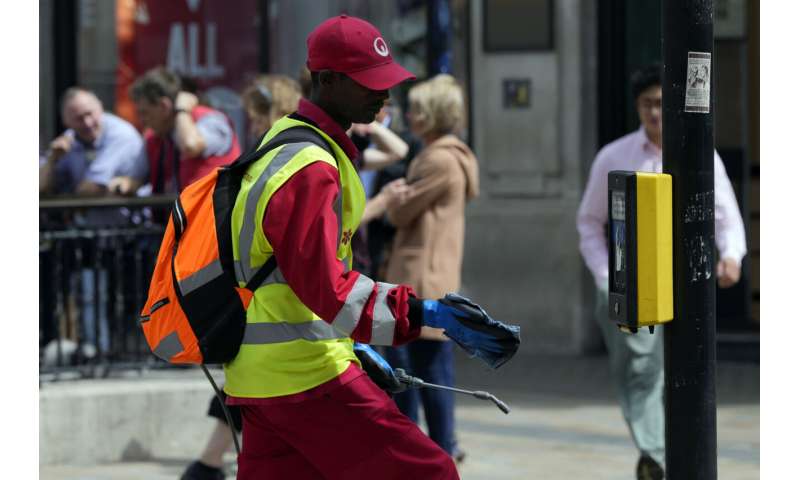 A Westminster Council contractor cleans the pedestrian crossing buttons with antibacterial agents against the coronavirus in London, Friday, Aug. 6, 2021. The number of covid positive tests for August 5, the latest available figure show the United Kingdom had just over 30,000 confirmed infections. Credit: AP Photo/Alastair Grant
A Westminster Council contractor cleans the pedestrian crossing buttons with antibacterial agents against the coronavirus in London, Friday, Aug. 6, 2021. The number of covid positive tests for August 5, the latest available figure show the United Kingdom had just over 30,000 confirmed infections. Credit: AP Photo/Alastair Grant Pedestrians wearing face masks enter Oxford Street tube station while wearing a face masks against the coronavirus in London, Friday, Aug. 6, 2021. The number of covid positive tests for August 5, the latest available figure show the United Kingdom had just over 30,000 confirmed infections. Credit: AP Photo/Alastair Grant
Pedestrians wearing face masks enter Oxford Street tube station while wearing a face masks against the coronavirus in London, Friday, Aug. 6, 2021. The number of covid positive tests for August 5, the latest available figure show the United Kingdom had just over 30,000 confirmed infections. Credit: AP Photo/Alastair Grant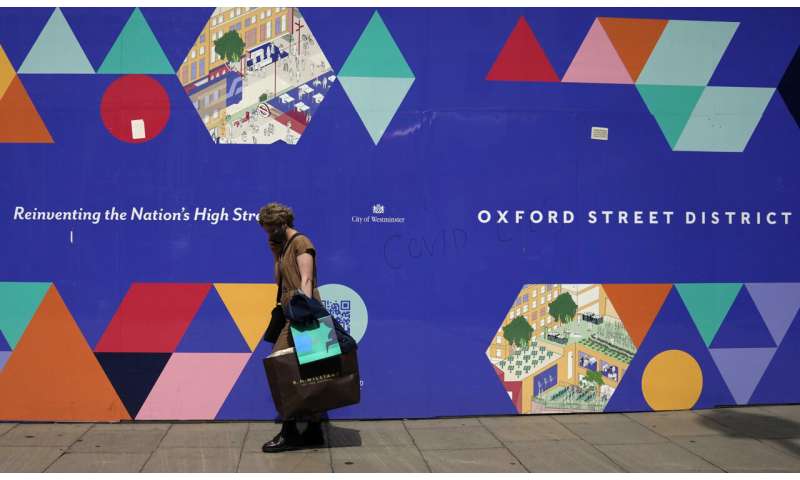 A woman speaks on her mobile phone while wearing a face mask against the coronavirus in London, Friday, Aug. 6, 2021. The number of covid positive tests for August 5, the latest available figure show the United Kingdom had just over 30,000 confirmed infections. Credit: AP Photo/Alastair Grant
A woman speaks on her mobile phone while wearing a face mask against the coronavirus in London, Friday, Aug. 6, 2021. The number of covid positive tests for August 5, the latest available figure show the United Kingdom had just over 30,000 confirmed infections. Credit: AP Photo/Alastair Grant Two women walk from a shop while wearing a face masks against the coronavirus in London, Friday, Aug. 6, 2021. The number of covid positive tests for August 5, the latest available figure show the United Kingdom had just over 30,000 confirmed infections. Credit: AP Photo/Alastair Grant
Two women walk from a shop while wearing a face masks against the coronavirus in London, Friday, Aug. 6, 2021. The number of covid positive tests for August 5, the latest available figure show the United Kingdom had just over 30,000 confirmed infections. Credit: AP Photo/Alastair Grant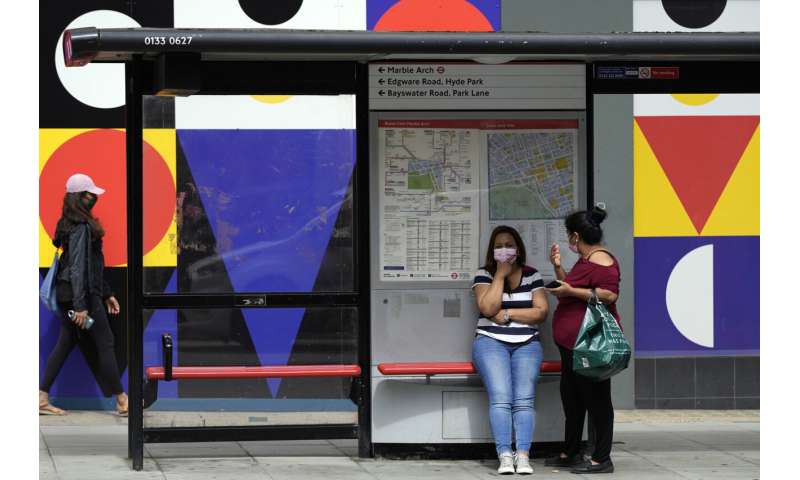 Two women wait at a bus stop in Oxford Street while wearing a face masks against the coronavirus in London, Friday, Aug. 6, 2021. The number of covid positive tests for August 5, the latest available figure show the United Kingdom had just over 30,000 confirmed infections. Credit: AP Photo/Alastair Grant
Two women wait at a bus stop in Oxford Street while wearing a face masks against the coronavirus in London, Friday, Aug. 6, 2021. The number of covid positive tests for August 5, the latest available figure show the United Kingdom had just over 30,000 confirmed infections. Credit: AP Photo/Alastair Grant Two women walk along Oxford Street while wearing a face masks against the coronavirus in London, Friday, Aug. 6, 2021. The number of covid positive tests for August 5, the latest available figure show the United Kingdom had just over 30,000 confirmed infections. Credit: AP Photo/Alastair Grant
Two women walk along Oxford Street while wearing a face masks against the coronavirus in London, Friday, Aug. 6, 2021. The number of covid positive tests for August 5, the latest available figure show the United Kingdom had just over 30,000 confirmed infections. Credit: AP Photo/Alastair Grant A woman walks along Oxford Street while wearing a face mask against the coronavirus in London, Friday, Aug. 6, 2021. The number of covid positive tests for August 5, the latest available figure show the United Kingdom had just over 30,000 confirmed infections. Credit: AP Photo/Alastair Grant
A woman walks along Oxford Street while wearing a face mask against the coronavirus in London, Friday, Aug. 6, 2021. The number of covid positive tests for August 5, the latest available figure show the United Kingdom had just over 30,000 confirmed infections. Credit: AP Photo/Alastair Grant
The falling rates of transmission in the U.K., which has seen 130,000 virus-related deaths, the world’s seventh-highest, has taken many scientists by surprise. Many had predicted a sharp pick-up this summer as a result of the more contagious delta variant and the lifting of lockdown restrictions.
Several reasons have been cited for the seeming fall in infections, which has led to a 13% decline in the number of people requiring hospital treatment for COVID-19 over the past week. These include ongoing caution among people despite the lifting of restrictions, the closure of schools for the summer and the ending of soccer’s European Championship, which had led many younger men to mingle indoors at home or in pubs.
And though the rollout of vaccines to younger age groups appears to have lost some steam, the U.K. rollout has been deemed a success. Figures on Friday showed that nearly 74% of the adult population—those aged 18 and above—have been fully vaccinated. Earlier this week, the government accepted the advice of scientists to offer the Pfizer vaccine to 16 and 17-year-olds.
Scientists said the COVID backdrop in the U.K. remains fragile and could flare up again in the months to come after the reopening of schools and the weather turns colder, prompting more and more people to stay inside.
Pan Pylas

